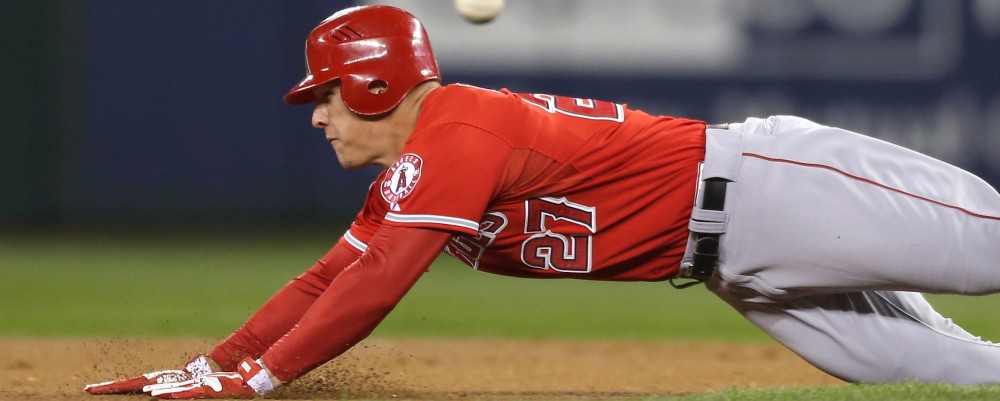Over the weekend I attended the SABR Analytics Conference in downtown Phoenix. A diverse collection of baseball historians, statheads, fans, front-office types and journalists — a few of us, at least — gathered to form a veritable baseball think tank. Presentations were made minor-league directiors, marketing folks, and even a few players (the Arizona Diamondbacks’ Brandon McCarthy and the San Francisco Giants’ Javier Lopez.)
A handful of us attended Jerry Dipoto‘s discussion of how the Angels use Bloomberg Sports’ all-purpose scouting software. I wrote this piece focusing on how Dipoto tries to communicate the data he gathers to players. As is often the case, I had to leave out a lot.
Bloomberg president Bill Squadron gave us the rundown on the Bloomberg Sports 2.0 GUI platform. Two thousand engineers worked on it. Their stats archive (courtesy of MLB Advanced Media and “other sources” that Squadron declined to identify — likely Retrosheet and/or Stats LLC) predate 1900 and their pitch-by-pitch data goes back to 2006.
These pitches can be filtered by pitcher, by game, by at-bat, and by sequence. As an example, Squadron showed a cluster of pitches (it looked like a rainbow-colored splotch of paint hovering above home plate) that represented every pitch San Francisco Giants right-hander Tim Lincecum threw in 2012. A few keystrokes later, Squadron showed us the following example of what the Bloomberg toy can do: When Lincecum starts a left-hander hitter with a fastball in the sixth inning, there’s a 54.5 percent chance he’ll throw that fastball again on the second pitch.
The data’s actually been out there for a few years but the all-in-one interface has not, and Bloomberg thinks its model is easy enough for even front-office technophobes to use. A year ago, Bloomberg released screenshots of the first iteration of its software but for the life of me I can’t find them online. Take my word for it that if you’re famliar with Gameday on MLB.com, you could slide right over to Bloomberg.
“Ten, 12 years ago, we’d be sitting here pulling up Baseball Cube and baseball-reference in order to reference one player and watch video on another screen because it’s not enough to fit on your desktop,” Dipoto said. “Now you just have to push a button … and it’s all customized.”
Dipoto says he’ll use the data for advance scouting from series to series, and also to track the progress of every player in the Angels’ system.
The minor-league data “allows us to make decisions about when to push that player forward in his progression,” Dipoto said. “What might be his flaw? Sometimes that might be found in pitch quality, the lack of an ability to throw a third strike. Certain metrics allow you to devlop a trend.”
Then there’s the Angels’ draft room, which makes the Oakland A’s 2002 “Moneyball” draft look like a sepia-toned parlor game from the deadball era.
“Sitting in the draft room — end of May, early June — we’re going through our high school and college players,” Dipoto said. “You get into the 18th round, you’re down to a small number of appealing players that you can’t separate. We can simply touch a button and say ‘give me all right-handed pitchers who we have graded out witha plus curveball’ … and they’ll filter though and we’ll have six names pop up. We’ll have a cue to decide, ‘here’s the six guys we focus on.’
“Inevitably whenever we do that, four guys will go off the board. It’s just like kickers in fantasy football.”
Dipoto stressed that all the charts in the world can’t replace the essential value of having a scout’s eyes on a player in person. But even scouting is quantified. Traditionally, a scout will rate players on a standard scale of 20 to 80 — 20 being the lowest number value assigned to a particular skill, 80 the highest.
But is every scout’s “80” the same? Is every “20”?
“We trisect the scouting department into conservative, super-aggressive and centric,” Dipoto said. “You can chart how scouts grade players. It allows us to make a better assessment of what that number means.”
So yes, Dipoto has numbers. Lots of them. “The player we sign and draft, we will have information from that kid from the first day we saw him to the day he retires or walks out of the organization. We’ll have that for other organizations as well. Keep the keys to your car because you never know when that guy’s going to walk through your doors.”

